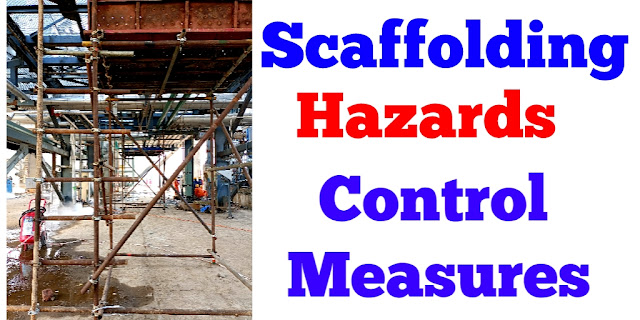Scaffolding Hazards: Causes and Control Measures
Scaffolding hazards are a very real concern in the construction industry. Working on or around scaffolding can be dangerous, and it is essential that everyone involved in the construction process is aware of the potential hazards and takes the necessary safety precautions to prevent them. In this blog post, we will discuss the most common scaffolding hazards and the control measures you should take to ensure the safety of yourself and others while working on or around scaffolding.
Scaffolding Hazards: Causes and Control Measures
 |
| Scaffolding Hazards: Causes and Control Measures |
Defining scaffolding / What is Scaffolding?
Scaffolding is a temporary structure used in construction work to support workers and materials during the construction process. It is an essential component of any construction site, providing a stable working platform for workers to access different parts of a building. Scaffolding types vary depending on the specific needs of the construction project, and they can be made from various materials such as steel, aluminum, or timber.
However, the use of scaffolding poses significant hazards that must be considered by construction workers and employers. These hazards of scaffolding in construction can range from falls, electrical hazards, collapse of the scaffold, or being struck by falling objects. As such, it is essential to identify the potential hazards of scaffolding and take measures to control them. In the following sections, we will explore the different types of scaffolding and potential hazards and measures to control them.
Scaffolding Hazards and Control Measures
Different types of scaffolding
There are various types of scaffolding that can be used on construction sites depending on the needs of the project. Each type of scaffolding has its unique characteristics, advantages, and disadvantages.
1. Supported Scaffolding: This type of scaffolding is commonly used on construction sites. It consists of a series of platforms supported by rigid poles, frames, or other structural supports.
2. Suspended Scaffolding: This type of scaffolding is typically used for maintenance work or painting on the exterior of tall buildings. The scaffolding is suspended from the top of the building and is held up by ropes or chains.
3. Rolling Scaffolding: Rolling scaffolding is used when workers need to move the scaffolding frequently around the site. The scaffolding consists of a platform that is mounted on wheels, making it easy to move from one location to another.
4. Cantilever Scaffolding: Cantilever scaffolding is used when workers need to work on the side of a building that does not have a foundation. The scaffolding is anchored to the floor and extends out from the building, providing workers with a stable platform.
5. Mobile Scaffolding: Mobile scaffolding is designed to be moved easily around the construction site. The scaffolding is mounted on wheels, making it easy to move from one location to another.
Knowing the types of scaffolding available is crucial for selecting the best option for the construction site. It is important to note that regardless of the type of scaffolding used, safety measures should always be followed to ensure the safety of workers.
Scaffolding Hazards: Causes and Control Measures
Scaffolding Hazards
1. Lack of fall protection.
Most common hazard associated with scaffolding is lack of fall protection such as working on scaffolding without guard rail and life line.
2. Fall of material.
Unsecured and loose material should not be kept on scaffold it can be fall and hit workers working near by scaffolding.
3. Uncertified scaffolding.
Working on uncertified or proper scaffolding is also a common scaffolding hazard.
If near scaffolding there is any electrical live power line then it con pose electric shock.
5. Bad weather condition.
such as heavy wind, rail & Hot weather.
6. Untrained workmen.
Workers working on scaffolding must be trained and aware of Scaffolding Hazards: Causes and Control Measures
Steps to control scaffolding hazards
Working with scaffolding can be risky business, especially if the proper safety measures are not put in place. There are several steps that workers and contractors can take to reduce the risk of scaffolding accidents.
1. Train Workers
Before anyone steps onto a scaffold, they must be trained on how to properly assemble and use the equipment. Workers should also be trained on how to identify potential hazards and how to respond to an emergency situation.
2. Conduct Regular Inspections
Scaffolding types vary and must be checked regularly to ensure they are still in good working order. Workers should inspect the equipment daily before use and report any damage or potential hazards.
3. Secure the Base
The foundation of the scaffolding must be level, solid, and secure. If the ground is not level, it may be necessary to use adjustable legs to compensate. Additionally, base plates or mud sills can be used to stabilize the foundation and prevent it from sinking into soft ground.
4. Use Proper Materials
Scaffolding materials should be strong, stable, and in good condition. Use only equipment that meets safety standards and follows the manufacturer's recommendations for weight limits.
5. Protect Against Falls
Falls are the most common hazard of scaffolding in construction. Workers should use guardrails, toe boards, and personal fall arrest systems to protect against falls. Safety nets can also be used to catch workers if they fall.
By following these steps, workers and contractors can reduce the risk of scaffolding accidents and ensure a safe work environment. Scaffolding may have its hazards, but proper preparation and safety precautions can make it a reliable tool for any construction job.
Scaffolding Hazards: Causes and Control Measures
Safe scaffolding practices
Scaffolding safety is of utmost importance in any construction project. Below are some safe scaffolding practices that must be followed to minimize risks and prevent accidents:
1. Properly erected and maintained scaffold:
The scaffold should be properly erected and maintained as per the manufacturer's instructions. It must be sturdy enough to support the workers and the materials. Any damaged parts must be replaced immediately, and regular inspections should be carried out to ensure the scaffold's integrity.
2. Securely anchored:
Scaffolding must be securely anchored to the structure or building it is supporting. Adequate support must be provided to avoid any tipping or falling. The scaffold should also be designed to withstand any lateral forces that may be encountered, such as wind.
3. Use of proper access points:
Workers must use proper access points, such as ladders or stairs, to climb up and down the scaffold. They should never attempt to climb the scaffold frame itself or the cross-braces as it may result in instability and potential accidents.
4. Fall protection:
Fall protection is essential when working at heights on scaffolding. Workers must be provided with harnesses and lanyards to secure themselves to the scaffold. Guardrails and toe boards must be installed on all open sides and ends of the scaffold.
5. No overcrowding:
Scaffolds must not be overcrowded, and workers should not carry excessive materials onto the scaffold. The load capacity of the scaffold must not be exceeded, and materials must be distributed evenly to avoid overloading.
ALSO READ: -
Scaffolding Hazards: Causes and Control Measures
Scaffolding Hazards & Control Measures
Scaffolding Hazards
Scaffolding safety precautions


.jpg)









.png)


0 Comments